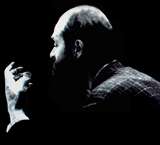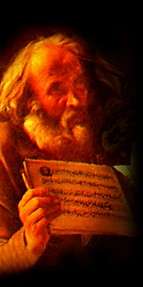 |
 |
 |
 |
 |
|
"Tintinnabulation is an area I sometimes wander into when I am searching for answer-in my life,my music,my work.In my dark hours,I have the certain feeling that everything outside this one thing has no meaning.The complex and many-faceted only confuses me,and I must search for unity.”
The statement by the Estonian composer Arvo Pärt refers to his present musical language,in which the simple harmonic and rhythmic structures-as well musical as music’s spiritual dimensions-are brought into the foreground.However,this musical style has not always been the way it is known to us today.During the 1960s he composed music in a modernistic idiom as well as using collage techniques,i.e. the mixing of music of different styles.
Trought composed at around the same time as his predominantly modernistic First and Second Symphonies ,Collage Sur Bach(1964) differs immensely from these two appears to have been composed later-it is a very modern piece in its use of different stylistic illusions.During the 1970s Pärt commented on his collage period,declaring that:”my collages were an attempt to replant a flower in alien surroundings(the problem of suitability of tissue:if they grow together into one,the transplantion was the right move).Here,however,the idea of transplantation was not in the fluctuation between the different stylistic idioms creates this new ‘flower in this piece.
The opening movement, Toccata,is energetic and full of motion-at first reminiscent of Baroque music. In the following atonal sections, the notes B (german for B flat)-A-C-H (german for B) areembedded in virtually every bar.This ties into a long tradition in music history of using this theme (originating in the words of J.S. Bach himself and later appearing in works by composers such as Schumann and List), but as this thematic cell constitues a small chromatic cluster, this theme has rarely been used as a chord.However, it is as a chord that Pärt uses B-A-C-H and in this context it creates a good contrast to the tonal introduction.
The second movement, Sarabande,also alternates between two different characters-an’authentic’ Baroque texture,featuring solo oboe,harpsichord and strings (the melody is in itself quoted from Bach’s Sarabande from the Sixth English Suite), that is intermixed with dense chords in the strings and clusters in the piano. Here too, the B-A-C-H theme is constantly present in the non-tonal sections- and, as Paul Hillier points out in his book on Pärt, the oboe melody is itself a disguised version of the B-A-C-H motif. Hillier also mentions that this motif occurs in several works by Pärt from that period.
The last movement, Ricercar ,is a fugue built from the melodic version of the B-A-C-H- theme. In good Baroque fashion and,indeed,in accordance with J.S.Bach’s own fugal practices,Pärt elaborates the theme in different ways-taking it in retrograde and invented as well as in prolonged note values.
 Two extensive periods silence played an important role in Pärt’s stlistic development. Of Pärticular importance was his study of Medieval music. One important outcome of this was his Third Symphony(1971) in which the Medieval references are clearly audible.After the second period of silence he returned as a composer in 1976 with a small piano piece, For Alina which marked his new approach to composition-his music became simplistic and meditative.His world-wide reputation (as manifested,for example, by his election as an honorary member of the American Academy of Arts and Letters in 1996) was earned on the basis of his latewr, most original style.
The Medieval features are less prominent in his post-1976 style as compared to the Third Symphony . Instead other aspects are featured, including canonical structures and modal rhythm.Perhaps of most vital importance is Pärt’s notion of tintinnabuli (tintinnabulum is the Latin for ‘bell’): ’I have discovered that it is enough when a single note is beautifully played.This one note... or a moment of silence,comforts me. I work with very few elements-with one voice,with two voices. I build with primitive materials-with the triad, with one specific tonality. The three notes of a triad are like bells. And that is why I call it tittinnabulation.’
Two extensive periods silence played an important role in Pärt’s stlistic development. Of Pärticular importance was his study of Medieval music. One important outcome of this was his Third Symphony(1971) in which the Medieval references are clearly audible.After the second period of silence he returned as a composer in 1976 with a small piano piece, For Alina which marked his new approach to composition-his music became simplistic and meditative.His world-wide reputation (as manifested,for example, by his election as an honorary member of the American Academy of Arts and Letters in 1996) was earned on the basis of his latewr, most original style.
The Medieval features are less prominent in his post-1976 style as compared to the Third Symphony . Instead other aspects are featured, including canonical structures and modal rhythm.Perhaps of most vital importance is Pärt’s notion of tintinnabuli (tintinnabulum is the Latin for ‘bell’): ’I have discovered that it is enough when a single note is beautifully played.This one note... or a moment of silence,comforts me. I work with very few elements-with one voice,with two voices. I build with primitive materials-with the triad, with one specific tonality. The three notes of a triad are like bells. And that is why I call it tittinnabulation.’
FRATRES(1977-) is a family of pieces that exists in versions for, ampng others, ensemble of early instruments, cello ensemble, string quarted and violin and piano. Fratres for string orchestra with percussion (version VI-1991) features a calm melody repeated with slight variations during nine phrases and superimposed over a drone (A-E) in the celli and basses.One of the middle Pärts takes care of the tittinnabulation, i.e.that Pärt plays only the notes in the A minor triad, A-C-E.Between each phrase there is a short interlude in the percussion section, played by claves and bass drum – an interlude that gives time for contemplation over what has just been heard.
“Why did the date of Benjamin Britten’s death – 4th December 1976 touch such a chord in me? ”Pärt aska,and continues: ”During this time I was obviusly at the point where I could recognize the magnitude of such a loss... I had just discovered Britten for myself. Just before his death I began to appreciate the unusual purity of his music... And besides,for a long time I had wanted to meet Britten personally-and now it would not come to that”. (It has been pointed out that this piece moved Britten’s Pärtner, Peter Pears, to tears.)
CANTUS IN MEMORIAM BENJAMIN BRITTEN for string orchestra and one bell(1977) is an excellent example of the influence Medieval music has had on Pärt – however tacitly. There are no Pärticular Medieval melodic or harmonic structures.Instead,the historical references are achieved in different ways. The whole piece is a double canon.The first violin leads one of the processes by expanding a descending diatonic scale by one step for each cycle until the low C has been reached. The lower instruments follow at different speed – as in the mensuration canons by composers such as Josquin and Ockeghem. Also the tintinnabulation Pärts appear in canon and at different speeds.
The whole procces ends when the lowest double bass Pärt reaches its goal – the low A. Another Medieval reference lies in the fact that the first top melody follows the first rhytmic mode, origination from the Notre Dame school during the twelfth century – long-short-long-short. A wonderful event in this piece occurs during the final bar when the bell is struck inaudibly and then resonates after the strings have stopped playing as if it were sounding from nowhere.
FESTINA LENTE (1988/90) displays many structural similarites with Cantus. The contradictory title ‘festina lente’ – ‘make haste slowly’ – was one of Emperor Augustus’s favourite maxims and refers here to the simultaneous performance of the melody in three different tempi: fast in the violins, medium in the viola, and slow in the celli and basses. As was the case in Cantus, Festina lente contains only those pitchesthat would be the white keys on the piano, without chromatic alterations.This piece may also be performed with a harp Pärt which gives resonance to the bass lines.
SUMMA (1991) was originally a choral piece, composed in 1978.Instead, Summa explorestwo-Pärt writting juxtaposed with tutti sections.The main melody itself presents the tintinnabulation Pärt,containing only the notes of the G minor triad.
TABULA RASA (1977) is Pärt’s extensive instrumental work. Inspired by the concerto grosso from the Baroque period – a small group of instruments, in this case two violins, againist the rest of the orchestra – the first movement,Con moto (with movement) , features Vivaldi-like textures resulting from its use of static rhythms and homophonic structure. The prepared piano – in which different objects are put into the instrument, thus creating different starling sounds (in this piece screws between the strings) – makes a clear reference to bells. The first movement develops through a juxtaposition of two different episodes: one rhythmically active and one calm section
in which only one violin and piano take Pärt.The motion in the active section increases gradually in register and rhythmic activity and culminates in an extensively arpeggiated, almost violent, section.
In the second movement, Senza moto (without movement) , the prepared piano servers an even more important function – providing the only rhythmic and coloristic contrasts to the extended canon sections in which the celli expand a diatonic scale upwards and downwards, similar to the tecnique used in Cantus ,followed in canon by the first violins.
Per F.Broman 1997
Bis records
|
|
|
|

